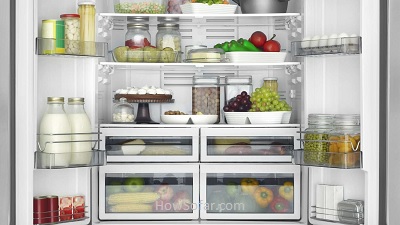Every second inhabitant of developed countries does it wrong: makes purchases and simply puts vegetables, meat, and fish where there is free space, milk, and eggs – as always, in the door. More organized people assign each zone its own purpose: ready-made meals and products that require cooking. But even in this case, new purchases are placed in front of those that were already in the refrigerator, and this complicates the control of shelf life.

Let’s check if your way of storing food in the refrigerator is correct. We will talk about three principles, and if you want, you can choose the most convenient among them.
How to store food in the refrigerator?
This is the simplest and most understandable principle, which, by the way, is recommended by refrigerator manufacturers themselves. Pay attention to the marks on the shelves. This method of storing food in the refrigerator is based on the temperature difference inside the cooling chamber: the lower and closer to the freezer, the colder.
The principle of storing food in the refrigerator depends on the temperature:
1. Top shelf suitable for:
- Dairy products (cheese, yogurt, kefir, sour cream);
- Ready-made pastries (cakes, cakes, rolls);
- Greens;
- Eggs.
2. The second shelf is a place to store food ready to eat:
- Smoked meats and sausages;
- Ready meals.
3. The bottom shelf is the coldest place in the refrigerator, designed to store such products:
- Raw meat;
- Ground meat;
- Fresh fish and seafood.
4. The bottom drawers have an optimal storage temperature:
- Fruits;
- Vegetables.
5. The door of the refrigerator is the warmest place with variable temperatures. Suitable for:
- Water and drinks (except milk);
- Hard cheese;
- Butter;
- Sauces.
Refrigerator Storage System
Employees of the restaurant business know everything about expiration dates. After all, if for you a jar of spoiled yogurt is nothing to worry about, then in the restaurant business food spoilage is a serious source of profit loss.

What does a restaurant refrigerator storage system look like:
- The top shelf is all fresh. This is what you just brought from the supermarket.
- The second shelf – what was previously on the top moves to it.
- The bottom shelf contains foods marked “eat first.” Here the temperature is usually 1-2 degrees lower than at the top, and this also extends the shelf life.
Storage organization works like this. You come from the store and lay out what you are going to eat from the bottom shelf. Products from the second shelf are sent to the vacated place (you will eat them tomorrow – the day after tomorrow), and everything from the top moves to the second. What was bought today is placed on the top shelf.
Looking into the refrigerator with thoughts about what to cook, take food from the bottom shelf, and then you won’t have to throw out the spoiled food.
You can also get Tips and Tricks for Cleaning and Maintaining Shiny Surfaces {2023}
Best Practices for Freezer Storage
In the freezer, the top drawers will be warmer than the bottom drawers. Therefore, the same rules for storing food apply here as in the refrigerator:
- In the lower zone (-24 … -17 ° C), it is better to have ice cream and meat – they are not afraid of such low temperatures.
- In the middle box (-16 … -14 ° C) it is optimal to store semi-finished products. At lower temperatures, they may lose their taste and properties.
- The top drawer (-14…-10 °C) is suitable for placing seafood, fish, vegetables, fruits, and butter.
In what containers and packaging should food be stored in the refrigerator
Whatever storage method you choose, to keep food longer and prevent the exchange of odors, the contents of the refrigerator must be sealed. To do this, you can use cling film or foil.
Another important point is that pots and pans made of aluminum, stainless steel, and cast iron are suitable for cooking, but are not intended for storage, because food oxidizes in them. It is convenient to use special containers for storing leftovers of ready meals. And ergonomic containers will help organize the contents of the shelves and use the space with maximum benefit.
Which containers to choose is up to you. You can take plastic ones – they are inexpensive and look pretty, or made of glass and enamel – such containers last longer and will be more environmentally friendly.
According to statistics, 20 to 60% of the food we buy is subsequently thrown away. Therefore, we hope that we will help you protect the products in the refrigerator from the consequences of improper storage. And this, in turn, will save not only your finances but also the irreplaceable resources of the planet.
FAQs of Store food in the refrigerator
Q1: Can I store all types of food in the refrigerator?
While refrigerators are suitable for many types of food, not all items require refrigeration. Some fruits, vegetables, and pantry staples can be stored at room temperature.
Q2: How long can I keep leftovers in the refrigerator?
Leftovers can be safely stored in the refrigerator for 3-4 days. Make sure to cool them quickly and store them in airtight containers.
Q3: Is it safe to store raw meat on the top shelf?
It’s recommended to store raw meat on the bottom shelf or in a designated meat drawer to prevent any juices from dripping onto other foods.
Q4: Can I freeze milk and eggs?
Yes, milk and eggs can be frozen. However, it’s best to remove a portion of the milk or beat eggs before freezing due to expansion. Thaw them in the refrigerator before use.
Q5: How can I prevent odor transfer in the refrigerator?
To minimize odor transfer, store strongly scented foods, like onions and garlic, in airtight containers. You can also place an open box of baking soda to absorb odors.



